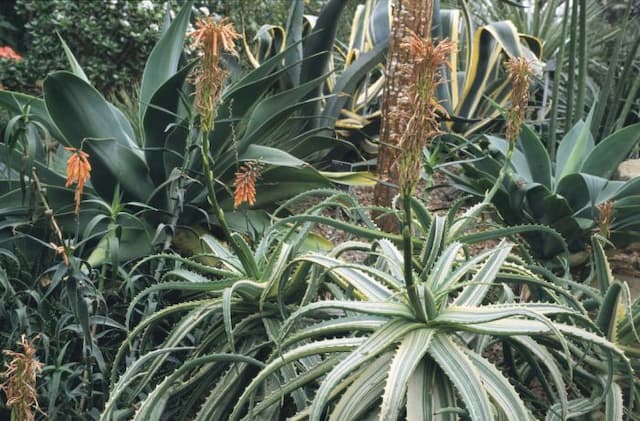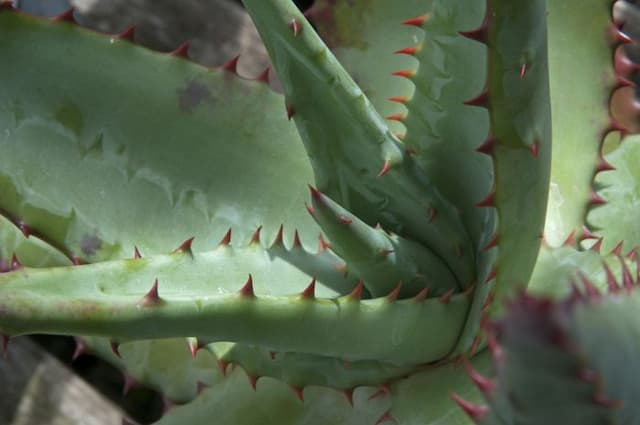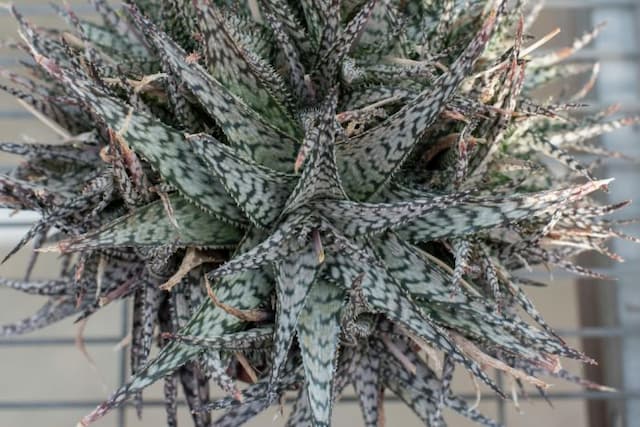Star Window Plant Haworthia venosa subsp. tesselata

ABOUT
This plant, known commonly as Haworthia venosa subsp. tesselata, has a distinctive and striking appearance characterized primarily by its chubby, textured leaves. The leaves are usually deep green in color and can sometimes have a translucent quality, particularly near their tips, which allows light to pass through and creates a unique, glowing effect. The plant's surface is covered with patterns that resemble a mosaic or network, giving it a tessellated look, which is where its name derives from. The patterns can be made up of various shapes, such as lines and markings that may appear white or lighter than the rest of the leaf, adding to its decorative appeal. The leaves are fleshy and grow in a rosette formation, which means they fan out from the central point of the plant in an attractive, symmetrical pattern. The rosettes are compact and the leaves may overlap, contributing to its dense and robust appearance. This plant often looks like a miniature, ornate succulent sculpture with its blend of sharp angles and curved edges. The surface texture of the leaves may feel rough or bumpy to touch due to the pronounced patterns on them. Overall, it presents itself as an architecturally interesting plant with a striking visual texture that makes it a popular choice for succulent enthusiasts and those looking for a low-maintenance houseplant with a modern aesthetic.
About this plant
 Names
NamesSynonyms
Star Window Plant, Tessellated Haworthia, Window Haworthia
Common names
Haworthia tesselata, Haworthia venosa var. tesselata, Catevala tesselata.
 Toxicity
ToxicityTo humans
Haworthia venosa subsp. tesselata, commonly known as simply Tessellated Haworthia, is generally considered non-toxic to humans. There are no significant toxic effects reported from ingesting this plant, and it is commonly kept as a houseplant without special precautions. However, ingestion of any plant material can potentially cause mild discomfort or an allergic reaction in certain individuals, so it is advised not to eat any part of the plant.
To pets
Tessellated Haworthia is also considered non-toxic to pets. This means that if a pet, such as a cat or dog, ingests part of this plant, they are unlikely to experience any significant symptoms of poisoning. As with humans, the ingestion of non-food plant material can result in gastrointestinal discomfort or potential allergy in some pets, but no severe toxic effects are expected from this specific plant species.
 Characteristics
CharacteristicsLife cycle
Perennials
Foliage type
Evergreen
Color of leaves
Green
Flower color
White
Height
4 inches (10 cm)
Spread
6 inches (15 cm)
Plant type
Succulent
Hardiness zones
10
Native area
Africa
Benefits
 General Benefits
General Benefits- Low Maintenance: Haworthia venosa subsp. tesselata is known for its ease of care, making it ideal for novice gardeners or those with a busy lifestyle.
- Drought Tolerant: It is highly tolerant to drought, requiring minimal watering, which is beneficial in water-scarce regions or for water conservation efforts.
- Small Size: Its compact size makes it perfect for small spaces, desktops, windowsills, and terrariums without requiring too much room.
- Aesthetic Appeal: The unique patterns and textures of its leaves add visual interest to any space, complementing various decor styles.
- Long Lifespan: With proper care, this succulent can live for many years, providing enduring enjoyment without the need for frequent replacement.
- Non-Toxic: Haworthia is non-toxic, making it a safe choice for homes with pets and children.
- Propagation Ease: It can be easily propagated from offsets, allowing for easy sharing with friends or expanding your own collection.
 Medical Properties
Medical PropertiesThis plant is not used for medical purposes.
 Air-purifying Qualities
Air-purifying QualitiesThis plant is not specifically known for air purifying qualities.
 Other Uses
Other Uses- Photography - Haworthia tessellata's intricate leaf patterns and translucent windows make it a popular subject for macro photography, allowing hobbyists and professional photographers to explore the beauty of plant textures and geometry.
- Education - Botany teachers use Haworthia tessellata to demonstrate succulent plant adaptations, such as water storage in leaves and photosynthesis through translucent parts in shade conditions.
- Feng Shui - The plant is sometimes incorporated in Feng Shui designs as it is believed to attract positive energy due to its harmonious structure and ease of growing.
- Art Inspiration - Artists may use the symmetric and geometric leaf patterns of the Haworthia tessellata as inspiration for designs, patterns in drawings, paintings, or textile work.
- Stress Relief - As a low-maintenance plant that does not require frequent care, it can be used for stress relief as interacting with plants can reduce psychological stress.
- Miniature Gardens - Its compact size makes it a suitable inhabitant for desktop terrariums or miniature fairy gardens.
- Office Decor - Haworthia tessellata can be used as a living desk accessory in offices, adding a touch of greenery without needing much space or specialized care.
- Educational Workshops - The plant can be a focus in workshops teaching about succulent care or terrarium building, offering hands-on experience with potting and designing with succulents.
- Gifts - They make for unique and sustainable gifts, especially for those interested in gardening or who appreciate natural decor.
- Jewelry - The small and intricate leaves of Haworthia tessellata can be encased in resin to create unique botanical jewelry pieces like pendants and earrings.
Interesting Facts
 Feng Shui
Feng ShuiThe Zebra Cactus is not used in Feng Shui practice.
 Zodiac Sign Compitability
Zodiac Sign CompitabilityThe Zebra Cactus is not used in astrology practice.
 Plant Symbolism
Plant Symbolism- Resilience: Haworthia venosa subsp. tesselata, commonly known as Tessellata, is a succulent that can survive in harsh conditions, symbolizing the ability to endure and persist through difficulties.
- Protection: The plant's sturdy structure and robust nature can represent a symbol of safeguarding oneself and others from the external environment, much like it protects its water reservoirs within its leaves.
- Beauty in simplicity: Tessellata, with its intricate patterns and modest appearance, can signify an appreciation for the understated beauty and the aesthetics of minimalism.
- Adaptability: Given its succulent characteristics, allowing it to adapt to less than ideal growing conditions, this plant stands for the ability to adjust and thrive in various environments and situations.
 Water
WaterThe Star Window Plant requires careful watering to prevent over-saturation. Water this succulent deeply but infrequently, allowing the soil to dry out completely between waterings. Generally, once every two to three weeks is adequate, but this may vary based on humidity and temperature conditions. When you do water, add enough so that water runs out of the drainage holes—this might equate to approximately 8-16 ounces for a small to medium pot. During the winter, reduce watering to once a month as the plant goes into dormancy.
 Light
LightThe Star Window Plant thrives best in bright, indirect light. It can tolerate some direct sunlight, but prolonged exposure to harsh direct sun could scorch its leaves. A location near a north or east-facing window provides optimal light conditions. If natural light is limited, artificial grow lights may also work well. Avoid placing your succulent in dimly lit areas, as this can lead to etiolation.
 Temperature
TemperatureThe Star Window Plant fares well in a wide range of temperatures, generally between 30 to 85 degrees Fahrenheit. However, it thrives in temperatures around 68 to 72 degrees Fahrenheit. It is not frost-tolerant, so if you live in an area with cold winters, make sure to bring it indoors or provide protection when temperatures fall below freezing.
 Pruning
PruningPruning the Star Window Plant is typically done to remove dead or withered leaves. Gently pull off the dried leaves at the bottom of the plant to encourage better growth and to maintain its appearance. Pruning is usually required infrequently, and the best time to prune is during the growing season in the spring or early summer.
 Cleaning
CleaningAs needed
 Soil
SoilHaworthia (Zebra Cactus) thrives in a soil mix that's well-draining and sandy, often consisting of a cactus potting mix combined with perlite or pumice for added drainage. It prefers a slightly acidic to neutral soil pH, ranging from 6.0 to 7.5. Regular potting soil should be avoided, or amended with sand and other inert materials to increase aeration and drainage.
 Repotting
RepottingZebra Cactus should be repotted every two to three years or when it outgrows its pot. The best time to repot is during the spring or early summer, using fresh succulent mix to ensure adequate drainage and to give the roots new room to grow.
 Humidity & Misting
Humidity & MistingZebra Cactus prefers low to moderate humidity levels, typical of indoor environments. It does not require high humidity and can tolerate dry air well, making it easy to maintain in most home settings.
 Suitable locations
Suitable locationsIndoor
Place Zebra Cactus in bright, indirect light and ensure pot has drainage.
Outdoor
Zebra Cactus thrives in partial shade with protection from intense sun.
Hardiness zone
9-11 USDA
 Life cycle
Life cycleThe life cycle of Haworthia venosa subsp. tesselata, commonly known as Tessellate Haworthia, begins with seed germination, which occurs when environmental conditions are favorable, providing enough warmth and moisture. The seedling stage follows, where initial roots and leaves begin to develop, growing slowly as they adapt to their surroundings. Over time, the plant enters its vegetative stage, with mature leaves forming the characteristic rosette pattern, and it develops its thick, fleshy leaves to store water, adapting to arid environments. The Tessellate Haworthia will eventually reach maturity and begin the reproductive stage, producing small flowers on slender inflorescences during the warmer months, which may attract pollinators or self-pollinate. After pollination and flowering, seeds are produced and dispersed, completing the cycle. Throughout its life, the plant may also propagate vegetatively through offsets, or "pups," that form at its base and can be separated to grow as new individuals.
 Propogation
PropogationPropogation time
Spring-Early Summer
Haworthia venosa subsp. tesselata, commonly known as the Tessellated Haworthia, is typically propagated through the division of offsets, which is the most popular method. This process is ideally done in the spring or early summer, when the plant’s growth is most active. The offsets, which are small rosettes that form at the base of the parent plant, can be gently pulled away when they have grown to a reasonable size, usually when they're about one-third the size of the parent. Take care not to damage the root system of the offset or the mother plant. Once separated, allow the offset to callous over for a day or two to prevent rot, and then plant it in well-draining soil. Use a pot that's proportionate to the size of the offset, and water sparingly until the new plant establishes a robust root system.









